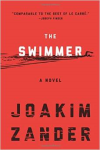I am a transcendence junky. The books I admire most on the ones where the protagonist evolves. While, I’ve tried to open my mind to books without transcendence, my reaction to the two books I’m reviewing show that I still need to work on my closed mind.
In her review of Let Me Die In His Footsteps by Lori Roy, Marilyn Stasio (crime book reviewer for the New York Times Book Review) said, “But its true colors emerge in the rich textures of the narrative, and in the music of that voice, as hypnotic as the scent coming off a field of lavender.” Maybe it was that voice that kept me reading this southern gothic novel because the plot was a dark as the Okfenokee Swamp at 2 am on a moonless night. Or, maybe it was my warped enjoyment of the challenges created by people who live in a different time and place than me. I’m not writing a full review because the ending shocked me. Being blindsided by an author is not a feat I appreciate.
What I do welcome is the character of Cassie Dewell in the new C.J. Box novel Badlands. I’ve been a Box fan for many years, but his Joe Picket series has been getting worn-out as Box searches for new adventures for Joe.
Badlands starts in the heat and humidity of North Carolina, but moves to the frozen tundra of North Dakota. Cassie Dewell has taken the job of lead investigator in the sheriff’s department of the newly booming oil town of Grimstad. With the creation of Cassie, Box has crafted a character I like. She is tough, calm, and smart. When she finds a severed human head in the refrigerator in her department owned apartment during her first evening in town, rather than scream or freak out she quietly places a necessary phone call.
Part of Badlands is from the point of view of Kyle Westergaard, a twelve year old boy born with fetal alcohol syndrome. One morning, while delivering newspapers on the frigid tundra Kyle witnesses something he doesn’t understand, and finds a package that only brings him trouble. While the plot is a fairly standard — bad drug guys versus the police — it is Kyle riding his bicycle along the snowy roads in twenty below zero temperatures that propels the story forward.





